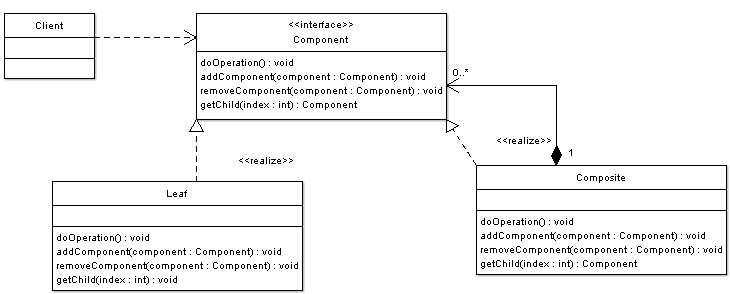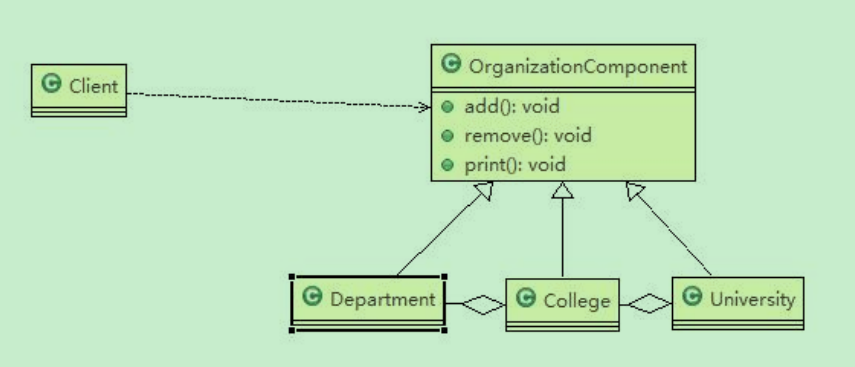Design Patterns(八) Composite
The composite pattern applies when there is a part-whole hierarchy of objects and a client needs to deal with objects uniformly regardless of the fact that an object might be a leaf or a branch.
前言 组合模式(Composite Pattern),又叫部分整体模式,是用于把一组相似的对象当作一个单一的对象。组合模式依据树形结构来组合对象,用来表示部分以及整体层次。这种类型的设计模式属于结构型模式,它创建了对象组的树形结构。
组合模式 基本介绍:
1) 组合模式(Composite Pattern),又叫部分整体模式,它创建了对象组的树形结构,将对象组合成树状结构以表示“整体-部分”的层次关系;
组合模式的三种角色:
1)Component(抽象组件角色): 是组合模式中Composite和Leaf共同的父接口(抽象类),在此接口中声明所有子类的共有的方法;
组合模式-UML图:
组合模式-案例图:
代码:
1 2 3 4 5 6 7 8 9 10 11 12 13 14 15 16 17 18 19 20 21 22 23 24 25 26 27 28 29 30 31 32 33 34 35 36 37 38 39 40 41 42 43 44 45 46 47 48 49 50 51 52 53 54 55 56 57 58 59 60 61 62 63 64 65 66 67 68 69 70 71 72 73 74 75 76 77 78 79 80 81 82 83 84 85 86 87 88 89 90 91 92 93 94 95 96 97 98 99 100 101 102 103 104 105 106 107 108 109 110 111 112 113 114 115 116 117 118 119 120 121 122 123 124 125 126 127 128 129 130 131 132 133 134 135 136 137 138 139 import java.util.ArrayList;import java.util.List;public class Composite public static void main (String[] args) OrganizationComponent university = new University("清华大学" , "Great University in China" ); OrganizationComponent computerCollege = new College("计算机学院" , "College of Computing" ); OrganizationComponent engineeringCollege = new College("工程学院" , "College of Engineering" ); university.add(computerCollege); university.add(engineeringCollege); computerCollege.add(new Department("软件工程" , "Software Engineering" )); computerCollege.add(new Department("信息工程" , "Information Engineering" )); computerCollege.add(new Department("计算机科学与计算" , "Computer Science and Technology" )); engineeringCollege.add(new Department("航空航天工程" , "Aeronautical Engineering" )); engineeringCollege.add(new Department("核工程" , "Nuclear engineering" )); engineeringCollege.add(new Department("生物医学工程" , "Biomedical Engineering" )); university.printMsg(); computerCollege.printMsg(); engineeringCollege.printMsg(); } } abstract class OrganizationComponent String name; String description; OrganizationComponent(String name, String description) { this .name = name; this .description = description; } void add (OrganizationComponent organizationComponent) } void remove (OrganizationComponent organizationComponent) } void printMsg () } } class University extends OrganizationComponent List<OrganizationComponent> components = new ArrayList<>(); University(String name, String description) { super (name, description); } @Override void add (OrganizationComponent component) components.add(component); } @Override void remove (OrganizationComponent component) if (components.size() == 0 ) { return ; } components.remove(component); } @Override void printMsg () System.out.println("********" + this .name + "********" + this .description + "********" ); if (components.size() == 0 ) { return ; } for (OrganizationComponent component : components) { System.out.println("" + component.name + "-->" + "component.description" ); } } } class College extends OrganizationComponent List<OrganizationComponent> components = new ArrayList<>(); College(String name, String description) { super (name, description); } @Override void add (OrganizationComponent component) components.add(component); } @Override void remove (OrganizationComponent component) if (components.size() == 0 ) { return ; } components.remove(component); } @Override void printMsg () System.out.println("========" + this .name + "========" + this .description + "========" ); if (components.size() == 0 ) { return ; } for (OrganizationComponent component : components) { System.out.println("" + component.name + "-->" + "component.description" ); } } } class Department extends OrganizationComponent Department(String name, String description) { super (name, description); } @Override void printMsg () System.out.println("--------" + this .name + "--------" + this .description + "--------" ); } }
总结 组合模式的注意事项和细节:
1) 简化客户端操作。客户端只需要面对一致的对象而不用考虑整体部分或者节点叶子的问题;
延伸 组合模式 组合模式-菜鸟教程 Composite Pattern Composite Design Pattern 组合模式-Composite Pattern 尚硅谷Java设计模式,韩顺平图解java设计模式
<
Algorithm Sort Introduction
Design Patterns(七) Decorator
>

